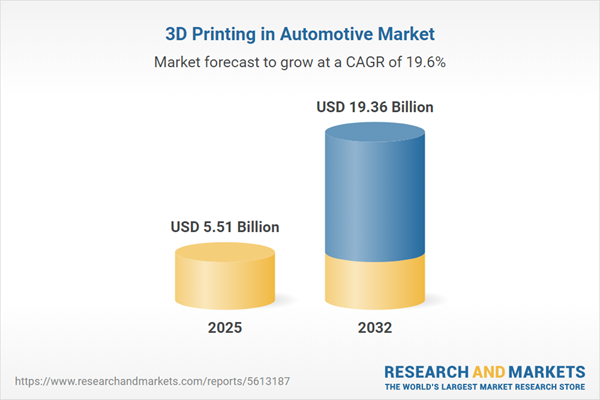Speak directly to the analyst to clarify any post sales queries you may have.
Additive manufacturing is rapidly transforming the automotive industry, serving as a catalyst for streamlined development cycles, agile supply chains, and accelerated innovation. Senior decision-makers are leveraging this technology to overcome traditional barriers in cost, customization, and production agility—positioning their organizations for sustained competitiveness.
Market Snapshot: 3D Printing in Automotive Market Overview
In 2024, the 3D Printing in Automotive Market was valued at USD 4.61 billion and is forecast to reach USD 5.51 billion by 2025. With a projected CAGR of 19.64%, the market is set to achieve USD 19.36 billion by 2032. This robust expansion reflects ongoing investments by automotive OEMs, tier suppliers, and supply chain partners seeking to harness additive manufacturing to reduce lead times, support innovative design approaches, and address shifting regulatory and customer demands across global regions.
Scope & Segmentation
This report delivers in-depth coverage of the entire value chain for 3D printing in automotive, exploring the impact of additive technologies across vehicles, components, and geographies. It provides segmented analysis of materials, processes, applications, components, equipment, services, software, and end-use vehicle types, while addressing regional developments and major players.
- Material Types: Ceramics (Alumina, Silicon Carbide, Zirconia), Composites (Carbon Fiber Reinforced, Glass Fiber Reinforced), Metals (Aluminum, Cobalt Chrome, Stainless Steel, Titanium), Polymers (Acrylonitrile Butadiene Styrene, Nylon, Photopolymers, Polycarbonate).
- Process Types: Direct Metal Laser Sintering, Fused Deposition Modeling (Closed Source, Open Source), Multi Jet Fusion, Selective Laser Sintering, Stereolithography (Digital Light Processing, Laser).
- Application Areas: End Use Parts (Exterior, Interior, Under The Hood Components), Prototyping (Functional, Visual), Tooling (Jigs Fixtures, Molds).
- Component Focus: Exterior Components, Interior Components, Under The Hood (Engine Components, Powertrain Components).
- Equipment & Services: Printers (Desktop, Industrial), Services (In House, Outsourced), Software (CAD, Simulation).
- End Use Vehicle Types: Commercial Vehicles (Buses, Trucks), Passenger Vehicles (Hatchbacks, Sedans, SUVs).
- Regions: Americas (United States, Canada, Mexico, Brazil, Argentina, Chile, Colombia, Peru), Europe, Middle East & Africa (UK, Germany, France, Russia, Italy, Spain, Netherlands, Sweden, Poland, Switzerland, UAE, Saudi Arabia, Qatar, Turkey, Israel, South Africa, Nigeria, Egypt, Kenya), Asia-Pacific (China, India, Japan, Australia, South Korea, Indonesia, Thailand, Malaysia, Singapore, Taiwan).
- Key Players: Stratasys Ltd., 3D Systems, Inc., EOS GmbH Electro Optical Systems, HP Inc., GE Additive, Materialise NV, SLM Solutions Group AG, Desktop Metal, Renishaw plc, voxeljet AG.
Key Takeaways for Senior Decision-Makers
- Additive manufacturing accelerates product development and reduces dependency on traditional tooling, supporting rapid prototyping and faster response to customization trends.
- Hybrid manufacturing models are gaining traction, combining additive and subtractive approaches to optimize production strategies and reduce operational complexity.
- Collaborative ecosystems, integrating advanced materials, simulation software, and design-focused services, are enabling design innovation and improving manufacturability.
- Regional investment trends reflect differing regulatory, sustainability, and localization imperatives—impacting where equipment, skills, and capacity enhancements are prioritized.
- Quality assurance is central as additive shifts from prototyping to end-use part production, prompting expanded certification frameworks and closer supplier relationships.
Impact of 2025 United States Tariff Measures
- Recent US tariffs have altered sourcing strategies, motivating firms to re-shore high-value additive processes and diversify supplier portfolios.
- Companies are re-evaluating feedstocks, balancing domestic alternatives with traditional imports to optimize cost structures and supply risks.
- Service providers have adjusted their pricing and inventory models to reflect new duty exposures, supporting faster local fulfillment and reducing cross-border material flows.
- Increased localization and vertical integration are enhancing resilience in the face of trade volatility and regulatory shifts.
Methodology & Data Sources
This report combines primary interviews with industry leaders and experts, technical literature review, standards analysis, and recent regulatory documentation. Comparative case studies and scenario analysis underpin actionable recommendations and ensure relevance across functional and regional contexts.
Why This Report Matters
- Empowers strategic planning by mapping technology options to specific component applications and vehicle types across global markets.
- Helps assess the impact of trade policies, material innovations, and emerging certification standards on sourcing and supplier strategies.
- Delivers insights necessary for phasing and scaling additive manufacturing investments while maintaining quality assurance and cost control.
Conclusion
Adoption of 3D printing in automotive manufacturing is redefining global supply chains and engineering processes. Strategic, phased integration enables organizations to capture efficiency gains and foster innovation while aligning with dynamic market and regulatory requirements.
Additional Product Information:
- Purchase of this report includes 1 year online access with quarterly updates.
- This report can be updated on request. Please contact our Customer Experience team using the Ask a Question widget on our website.
Table of Contents
3. Executive Summary
4. Market Overview
7. Cumulative Impact of Artificial Intelligence 2025
Companies Mentioned
The companies profiled in this 3D Printing in Automotive market report include:- Stratasys Ltd.
- 3D Systems, Inc.
- EOS GmbH Electro Optical Systems
- HP Inc.
- GE Additive, LLC
- Materialise NV
- SLM Solutions Group AG
- Desktop Metal, Inc.
- Renishaw plc
- voxeljet AG
Table Information
| Report Attribute | Details |
|---|---|
| No. of Pages | 189 |
| Published | October 2025 |
| Forecast Period | 2025 - 2032 |
| Estimated Market Value ( USD | $ 5.51 Billion |
| Forecasted Market Value ( USD | $ 19.36 Billion |
| Compound Annual Growth Rate | 19.6% |
| Regions Covered | Global |
| No. of Companies Mentioned | 11 |









